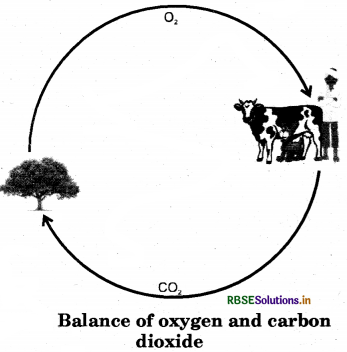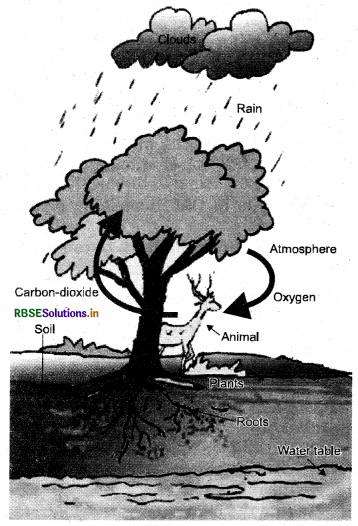RBSE Solutions for Class 7 Science Chapter 17 Forests: Our Lifeline
Rajasthan Board RBSE Solutions for Class 7 Science Chapter 17 Forests: Our Lifeline Textbook Exercise Questions and Answers.
Rajasthan Board RBSE Solutions for Class 7 Science in Hindi Medium & English Medium are part of RBSE Solutions for Class 7. Students can also read RBSE Class 7 Science Important Questions for exam preparation. Students can also go through RBSE Class 7 Science Notes to understand and remember the concepts easily. The class 7 science chapter 4 heat extra questions are curated with the aim of boosting confidence among students.
RBSE Class 7 Science Solutions Chapter 17 Forests: Our Lifeline
RBSE Class 7 Science Forests: Our Lifeline InText Questions and Answers
Page 212
Question 1.
Paheli reminded their friends that they have studied photosynthesis in chapter 1.
Answer:
The process of preparing food from CO2 and water by the chlorophyll containing leaves of plants in the presence of sunlight is called photosynthesis. Carbohydrate and oxygen is produced in this process.

Page 213
Question 2.
Paheli remembered that she saw a pipal sapling on the sidewall in her school. Can you help her to understand how this would have happened?
Answer:
The peepal seed might have reached on the sidewall of school through the dropping of birds. It germinates there due to presence of moisture in the air and grows in sapling.
Page 215
Question 3.
What would happen if forests disappear?
Answer:
If forests disappear, the amount of carbon dioxide in the air will increase which in turn increase the Earth’s temperature. Many animals, birds and plants will lose their natural habitat. The soil will erode faster and chances of flood will increase. We will not be able to avail mainy things such as food, furniture, paper, wood fuel, gum, rubber etc. Hence, disappearing of forest will make our survival difficult.
RBSE Class 7 Science Forests: Our Lifeline Textbook Questions and Answers
Question 1.
Explain how animals dwelling in the forest help it grow and regenerate.
Answer:
Animals help in the growth and regeneration of the forest in many ways. The excreta or droppings of animals are decomposed by bacteria and add the nutrient content to the soil. This helps to increase soil fertility and helps in the growth of new plants. Secondly, many animals also help in seed dispersal either by eating and dropping the seed at a different places along with their excreta. Sometimes seeds get attached to their fur by the spikes.
Question 2.
Explain how forests prevent floods?
Answer:
Forests act as a natural absorber of rain water. Rain water does not directly hit the forest floor. It has to pass through a thick canopy. The water comes down through the branches and the stem of the tree and absorbed by the root of the tree. The rain water also comes down through the leaves slowly by dripping over the branches of shrubs and herbs. So, overflow of water cannot take place hence, flood is prevented.
Question 3.
What are decomposers? Name any two of them. What do they do in the forest?
Answer:
Decomposers are a group of micro - organisms that help to decompose waste or dead organic matter of either plant or animal resulting in the formation of humus. For example - some bacteria and fungi. They help to return the nutrients of dead and decaying substances back to the soil, so that they can be used by the living plants.
Question 4.
Explain the role of forest in maintaining the balance between oxygen and carbon dioxide in the atmosphere.
Answer:
Plants maintain the balance by performing two simultaneous processes - respiration and photosynthesis. During photosynthesis, plants produce oxygen into the atmosphere which is used by most of the other plants and animals for aerobic respiration that produce carbondioxide. The carbon dioxide is again taken up by the plants to perform photosynthesis.

The cycle described above goes on and thus helps in maintaining the balance of both these gases in the atmosphere.
Question 5.
Explain why there is no waste in a forest?
Answer:
The herbivorous eat the plants, the carnivorous eat the herbivorous, the dead animals are eaten by scavengers such as vultures and the dead remains of all organisms along with their excreta are converted to humus by decomposers. Humus provides nutrient to soil which helps in growth of plant. Therefore, everything that is produced is consumed and this cycle continues. Hence, nothing goes waste in the forests.
Question 6.
List five products we get from forests.
Answer:
Five products obtained from forests include:
- Medicinal plants
- Wax
- Gum
- Wood
- Rubber.
Question 7.
Fill in the blanks:
(a) The insects, butterflies, honeybees and birds help flowering plants in ...........................
(b) A forest is a purifier of ........................... and ...........................
(c) Herbs form the ........................... layer in the forest.
(d) The decaying leaves and animal droppings in a forest enrich the ...........................
Answer:
(a) pollination
(b) air, water
(c) lowest
(d) soil.
Question 8.
Why should we worry about the conditions and issues related to forests far from us?
Answer:
Forests are the very important natural resources and we should make every effort to conserve them.
1. Without forests, our home would be without furniture. We would not have pencils, erasers, gum, honey and many other products.
2. With the destruction of forests, many animals and birds species would become extinct as they lose their habitat.
3. The water cycle would be disturbed.
4. Soil erosion and flooding would increase.
5. The balance of O2 and CO2 in the atmosphere would be disturbed.

Question 9.
Explain why there is a need of variety of animals and plants in a forest?
Answer:
A greater variety of plants would mean greater opportunities for food and shelter for the herbivores. Greater the herbivore population means greater will be the food availability for carnivores. The wide variety of animals and plants thus helps to maintain the atmosphere through the food chain and helps the forest to continuously regenerate itself.
Question 10.
In fig. the artist has forgotten to put the labels and directions on the arrows. Mark the directions on the arrows and label the diagram using the following labels: clouds, rain, atmosphere, carbon - dioxide, oxygen, plants, animals, soil, roots, water table.

Question 11.
Which of the following is not a forest product?
(i) Gum
(ii) Plywood
(iii) Sealing wax
(iv) Kerosene.
Answer:
(iv) Kerosene.
Question 12.
Which of the following statements is not correct?
(i) Forests protect the soil from erosion.
(ii) Plants and animals in a forest are not dependent on one another.
(iii) Forests influence the climate and water cycle.
(iv) Soil helps forests to grow and regenerate.
Answer:
(ii) Plants and animals in a forest are not dependent on one another.
Question 13.
Micro - organisjms act upon the dead plants to produce:
(i) sand
(ii) mushrooms
(iii) humus
(iv) wood
Answer:
(iii) humus.

- RBSE Class 7 Science Notes in Hindi & English Medium Pdf Download
- RBSE Class 7 Science Important Questions in Hindi Medium & English Medium
- RBSE Solutions for Class 7 Science in Hindi Medium & English Medium
- RBSE Class 7 Science Important Questions Chapter 1 Nutrition in Plants
- RBSE Class 7 Science Notes Chapter 1 Nutrition in Plants
- RBSE Class 7 Science Important Questions Chapter 14 Electric Current and its Effects
- RBSE Class 7 Science Important Questions Chapter 13 Motion and Time
- RBSE Class 7 Science Important Questions Chapter 2 Nutrition in Animals
- RBSE Class 6 Science Notes Chapter 8 शरीर में गति
- RBSE Class 7 Science Notes Chapter 18 Wastewater Story
- RBSE Class 7 Science Notes Chapter 17 Forests: Our Lifeline